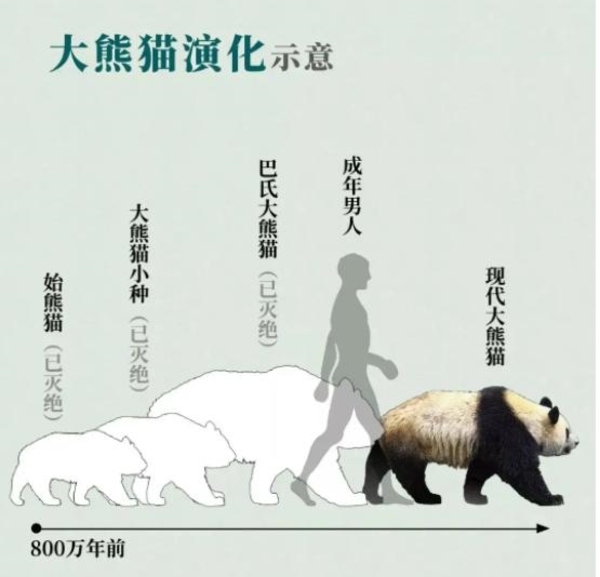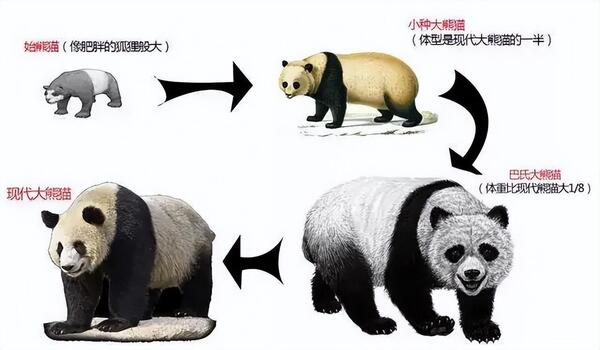The giant panda (Ailuropoda melanoleuca) is one of the most iconic and endangered species in the world, exclusively found in the mountainous forests of China. While modern pandas are well known for their bamboo-based diet and distinctive black-and-white fur, their evolutionary history spans millions of years. Scientific research, including fossil evidence and genetic analysis, has provided a comprehensive understanding of panda evolution, from their ancestral origins in the Late Miocene to their current conservation challenges.
The earliest known ancestor of the giant panda is Ailurarctos, also known as the primal panda, which lived during the Late Miocene (7-8 million years ago). Fossils discovered in Lufeng, Yunnan Province, reveal that these pandas were much smaller than their modern descendants, roughly the size of a large dog.
The teeth structure of Ailurarctos suggests that it had already begun to adapt to a bamboo-based diet.
Fossil analysis indicates the development of strong premolars, suited for chewing fibrous plant material.
This marks the earliest transition towards herbivory in panda evolution, differentiating them from other Ursidae (bear family) members.
By the Early Pleistocene (2 million years ago), pandas had further evolved into a species known as Ailuropoda microta, commonly referred to as the "small panda". Fossils of this species have been found in Liucheng, Guangxi Province, and Wushan, Chongqing, where a complete skull was discovered in 1984.
Smaller skull size compared to modern pandas, suggesting a gradual increase in body mass over time.
Further specialization of teeth and jaw strength, indicating an even stronger dependence on bamboo.
Reduction in carnivorous tendencies, as dietary studies of fossilized teeth suggest minimal meat consumption.
This period marks a crucial turning point in giant panda evolution, where their physical characteristics began resembling their modern counterparts.

Around 1 million years ago, the giant panda reached its evolutionary peak with the emergence of Ailuropoda baconi, also known as Baconi’s panda. Fossils of this species have been found in Guangxi Province, indicating a larger body size—approximately 2 meters in length—making it one of the largest panda species in history.
Fossils discovered at prehistoric human sites suggest that pandas were hunted by early humans.
Some fossilized panda bones contain cut marks, providing evidence that pandas may have been a food source for prehistoric humans.
This period represents the height of panda diversity, with several regional subspecies spread across different parts of China.
Over the past 20,000 years, giant pandas have experienced a gradual decline due to climate change, habitat loss, and human activity. The modern giant panda (Ailuropoda melanoleuca) is the only surviving species of this once-diverse lineage.
During the last Ice Age, cooling temperatures forced many mammal species in North China to migrate southward, leading to increased competition for resources.
The shrinking of bamboo forests restricted panda populations to isolated mountainous regions in Sichuan, Shaanxi, and Gansu.
Deforestation and human expansion in modern times have further contributed to the decline in panda populations.
Today, wild giant pandas are highly fragmented, with isolated populations facing low genetic diversity.
Conservation programs, such as captive breeding and habitat restoration, aim to increase genetic diversity and reintroduce pandas into the wild.
Organizations such as the China Conservation and Research Center for the Giant Panda (CCRCGP) and Wolong National Nature Reserve are leading efforts to protect panda populations.

The evolution of the giant panda is a testament to the species’ resilience and adaptation to environmental challenges. From the primal panda of the Miocene to the modern giant panda, these animals have overcome numerous evolutionary hurdles. However, the challenges they face today—habitat destruction, climate change, and genetic isolation—require urgent conservation efforts.
✅ The giant panda's evolutionary journey began 7-8 million years ago with the primal panda (Ailurarctos).
✅ 2 million years ago, the small panda (Ailuropoda microta) marked an important transitional phase.
✅ 1 million years ago, Baconi’s panda (Ailuropoda baconi) represented the species' peak in size and distribution.
✅ Over the past 20,000 years, climate change and human activities led to the decline of giant pandas.
✅ Today, modern giant pandas (Ailuropoda melanoleuca) survive mainly due to conservation programs in China.
With continued conservation efforts, giant pandas have a chance to thrive once more, ensuring that this remarkable species remains a symbol of biodiversity and wildlife preservation.
animal tags: Ursidae
We created this article in conjunction with AI technology, then made sure it was fact-checked and edited by a Animals Top editor.